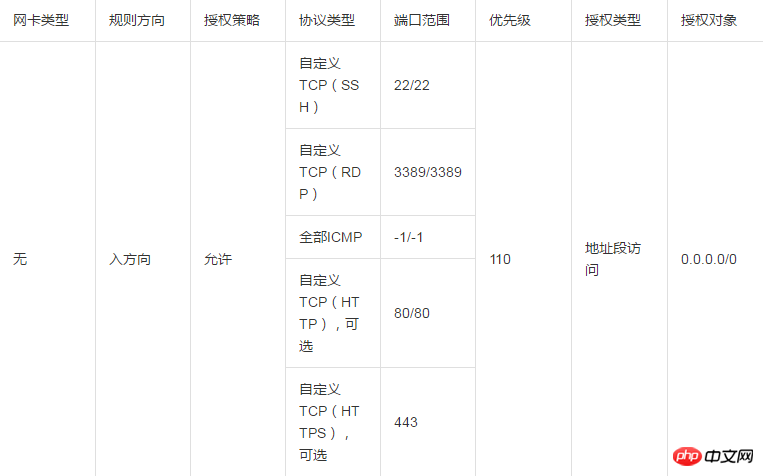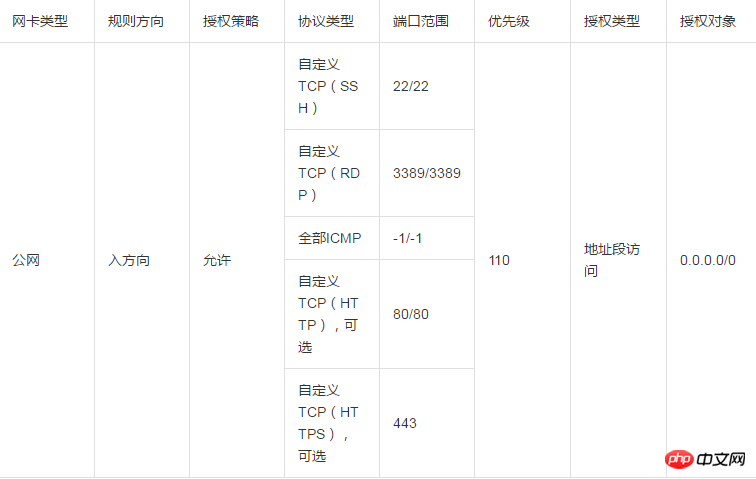 Operation and Maintenance
Operation and Maintenance
 Linux Operation and Maintenance
Linux Operation and Maintenance
 The default security group automatically created by the system and the default rules of the security group created by yourself
The default security group automatically created by the system and the default rules of the security group created by yourself
The default security group automatically created by the system and the default rules of the security group created by yourself
This article introduces the default security group automatically created by the system and the default rules of the security group created by yourself, and focuses on the specific steps.
Default rules for security groups
This article introduces the default security groups automatically created by the system and the default rules for the security groups you create yourself.
Description
Security groups are stateful. If the data packet is allowed in the outbound direction, then the corresponding connection is also allowed in the inbound direction. For more concepts related to security groups, see Security Groups.
The default security group automatically created by the system
When creating an ECS instance in a region, if the current account has not yet created a security group in this region , you can select the default security group automatically created by the system, as shown in the figure below.

The default rules in the default security group only set inbound rules for ICMP protocols, SSH port 22, RDP port 3389, HTTP port 80, and HTTPS port 443. Different network types have different security group rules.
VPC: VPC type security group rules do not distinguish between the intranet and the public network. Public network access to VPC type ECS instances is completed through private network card mapping. Therefore, you cannot see the public network card inside the instance, and you can only set intranet rules in the security group. Security group rules take effect on both the intranet and the public network. The default rules of the VPC type default security group are as shown in the following table.

The default rules of the classic network default security group are as shown in the following table. 
Description
The priority of the default security group rule is 110, which means that the priority of the default rule is always lower than the security group rule you add manually and can be overwritten at any time. When adding security group rules manually, the priority range is [1, 100]. For information about the priority of security group rules, see ECS security group rule priority description.
Based on business needs, you can add security group rules to the default security group.
Security group created by yourself
After creating the security group and before adding any security group rules, the default rules for the intranet and public network are as follows :
Outbound direction: All access allowed.
Inbound direction: Deny all access.
If your instance is in such a new security group, you can only use the management terminal to connect to the ECS instance, but you cannot log in to the instance through remote connection software, whether you use username and password authentication to connect to the Linux instance or use The software connects to Windows instances.
Based on business needs, you can add security group rules to your self-created security group.
The above is the detailed content of The default security group automatically created by the system and the default rules of the security group created by yourself. For more information, please follow other related articles on the PHP Chinese website!

Hot AI Tools

Undresser.AI Undress
AI-powered app for creating realistic nude photos

AI Clothes Remover
Online AI tool for removing clothes from photos.

Undress AI Tool
Undress images for free

Clothoff.io
AI clothes remover

Video Face Swap
Swap faces in any video effortlessly with our completely free AI face swap tool!

Hot Article

Hot Tools

Notepad++7.3.1
Easy-to-use and free code editor

SublimeText3 Chinese version
Chinese version, very easy to use

Zend Studio 13.0.1
Powerful PHP integrated development environment

Dreamweaver CS6
Visual web development tools

SublimeText3 Mac version
God-level code editing software (SublimeText3)

Hot Topics
 1387
1387
 52
52
 How to use docker desktop
Apr 15, 2025 am 11:45 AM
How to use docker desktop
Apr 15, 2025 am 11:45 AM
How to use Docker Desktop? Docker Desktop is a tool for running Docker containers on local machines. The steps to use include: 1. Install Docker Desktop; 2. Start Docker Desktop; 3. Create Docker image (using Dockerfile); 4. Build Docker image (using docker build); 5. Run Docker container (using docker run).
 How to view the docker process
Apr 15, 2025 am 11:48 AM
How to view the docker process
Apr 15, 2025 am 11:48 AM
Docker process viewing method: 1. Docker CLI command: docker ps; 2. Systemd CLI command: systemctl status docker; 3. Docker Compose CLI command: docker-compose ps; 4. Process Explorer (Windows); 5. /proc directory (Linux).
 What to do if the docker image fails
Apr 15, 2025 am 11:21 AM
What to do if the docker image fails
Apr 15, 2025 am 11:21 AM
Troubleshooting steps for failed Docker image build: Check Dockerfile syntax and dependency version. Check if the build context contains the required source code and dependencies. View the build log for error details. Use the --target option to build a hierarchical phase to identify failure points. Make sure to use the latest version of Docker engine. Build the image with --t [image-name]:debug mode to debug the problem. Check disk space and make sure it is sufficient. Disable SELinux to prevent interference with the build process. Ask community platforms for help, provide Dockerfiles and build log descriptions for more specific suggestions.
 What computer configuration is required for vscode
Apr 15, 2025 pm 09:48 PM
What computer configuration is required for vscode
Apr 15, 2025 pm 09:48 PM
VS Code system requirements: Operating system: Windows 10 and above, macOS 10.12 and above, Linux distribution processor: minimum 1.6 GHz, recommended 2.0 GHz and above memory: minimum 512 MB, recommended 4 GB and above storage space: minimum 250 MB, recommended 1 GB and above other requirements: stable network connection, Xorg/Wayland (Linux)
 vscode cannot install extension
Apr 15, 2025 pm 07:18 PM
vscode cannot install extension
Apr 15, 2025 pm 07:18 PM
The reasons for the installation of VS Code extensions may be: network instability, insufficient permissions, system compatibility issues, VS Code version is too old, antivirus software or firewall interference. By checking network connections, permissions, log files, updating VS Code, disabling security software, and restarting VS Code or computers, you can gradually troubleshoot and resolve issues.
 Can vscode be used for mac
Apr 15, 2025 pm 07:36 PM
Can vscode be used for mac
Apr 15, 2025 pm 07:36 PM
VS Code is available on Mac. It has powerful extensions, Git integration, terminal and debugger, and also offers a wealth of setup options. However, for particularly large projects or highly professional development, VS Code may have performance or functional limitations.
 What is vscode What is vscode for?
Apr 15, 2025 pm 06:45 PM
What is vscode What is vscode for?
Apr 15, 2025 pm 06:45 PM
VS Code is the full name Visual Studio Code, which is a free and open source cross-platform code editor and development environment developed by Microsoft. It supports a wide range of programming languages and provides syntax highlighting, code automatic completion, code snippets and smart prompts to improve development efficiency. Through a rich extension ecosystem, users can add extensions to specific needs and languages, such as debuggers, code formatting tools, and Git integrations. VS Code also includes an intuitive debugger that helps quickly find and resolve bugs in your code.
 How to back up vscode settings and extensions
Apr 15, 2025 pm 05:18 PM
How to back up vscode settings and extensions
Apr 15, 2025 pm 05:18 PM
How to back up VS Code configurations and extensions? Manually backup the settings file: Copy the key JSON files (settings.json, keybindings.json, extensions.json) to a safe location. Take advantage of VS Code synchronization: enable synchronization with your GitHub account to automatically back up all relevant settings and extensions. Use third-party tools: Back up configurations with reliable tools and provide richer features such as version control and incremental backups.



